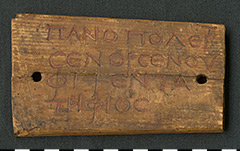T.Berl.Möller 134 = SB I 3440 (ÄM 13350)
This wooden tablet, a so called mummy label, belonged to a women named Senorsenuphis, daughter of Psentatriphis. The name of the deceased is carved into the wood in four lines of Greek text and afterwards retraced with black and red ink. The text also mentions the mummy`s provenience the ninth Upper Egyptian Nome Panopolites. Unlike other mummy label texts no specific date is given on this one. Therefore, the object can only be dated paleographically between the 2nd and 3rd centuries AD.
The first mummy labels appeared during the 1st century AD and were very popular in the following centuries. The little tablets contain the name of the deceased, usually with filiation and often also his age. They can be written in Greek or Egyptian language, the latter exclusively in demotic script. Mummy labels were only used by members of the lower social class.
The main function of the labels is the identification of the mummified body. Since the place of burial was highly important, the mummies were transported over long distances, mainly by ship, until they arrived at their final resting place. Transport documents furnish information about cost, provenance, destination and other details of the cargo. However, there seems to be evidence that the mummy labels also acted as a kind of grave stelae, something most people of the lower classes were not able to afford. In addition to the necessary information most of the demotic labels contain religious formulae which were also used on gravestones. A Greek mummy label at the British Museum even calls itself a “stele”.
Most of the known labels were acquired through the antiquities market. Therefore, their finding context is mostly unknown. Sometimes, the provenance can be deduced through the text, just like with this mummy label. Especially the necropolis of Akhmim and Sohag appear to be the origin of many of the acquired labels.



